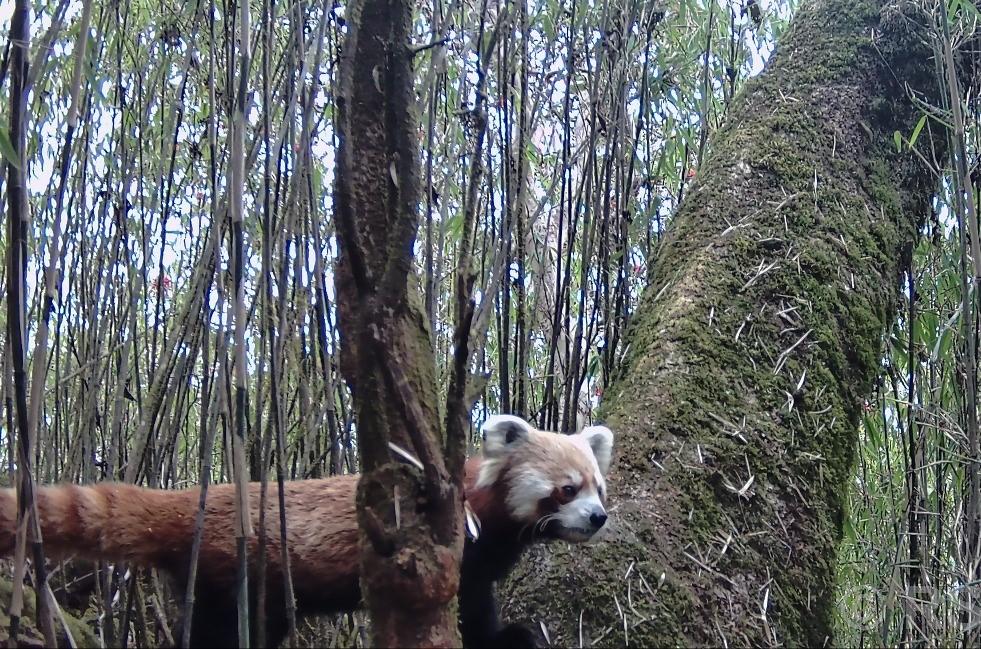

MYAGDI: In a promising sign for wildlife conservation, several endangered red pandas have been spotted in the Jaljala, Muna, and Mareni forest areas of Dhaulagiri Rural Municipality Wards 2 and 3 in western Nepal.
The sightings were confirmed through camera traps installed by researchers studying the region’s biodiversity. “After we found red panda droppings during a month-long field study, we set up three camera traps. Red pandas were captured in two of them,” said Pawan Rai, Program Officer at the Biodiversity Conservation Society Nepal (BIOCOS Nepal). “Our research confirms that between six and twenty-five red pandas are currently inhabiting the area.” Teams of local residents and researchers surveyed several surrounding locations — including Khibang, Mudi, Arche, Dar, Takam, Bagar, Simkosh, the Italian Base Camp, Mareni, Lulang, Gurjakhani, and Gurja Deurali — to assess red panda presence.
Local villagers had previously shared photos and videos of red panda sightings in the Dhorpatan Hunting Reserve’s Gurjaghat area in October 2023 and the Dahpatal Community Forest of Muna in December 2024. Earlier, in 2016, researchers from the Red Panda Network and the Himalayan Conservation Forum, supported by the World Wildlife Fund (WWF) and the Green Forest Program, had found red panda droppings in Mareni. Researcher Larisa Gautam said the discovery could open up eco-tourism opportunities that generate income and employment for local communities. “Jaljala lies close to the tourism capital Pokhara, and its landscape offers a unique mix of Himalayan scenery and red panda habitats,” Gautam said. “We can develop eco-trails, homestays, and even adventure events linked to red panda conservation.” Bishnu Prasad Adhikari, chief of the Dhaulagiri Division Forest Office, said while exact numbers are uncertain, red pandas are believed to be relatively abundant in the forests of Gurja, Lulang, and Muna.
The animals typically rest in tree canopies during the day and descend at night to feed on bamboo shoots and other vegetation. The forests in these areas have an ample supply of bamboo and tree species vital for red panda survival. Nepal’s National Parks and Wildlife Conservation Act of 1973 lists the red panda as a protected species. Those convicted of poaching face up to ten years in prison and fines ranging from Rs. 100,000 to Rs. 500,000. Recent studies estimate Nepal’s red panda population at just 500 to 1,000 individuals. Globally, the species is found only in Nepal, China, India, Bhutan, and Myanmar.
Researchers have identified Nepal’s red pandas as belonging to the Ailurus fulgens species. Meanwhile, with financial support from the Toledo Zoo Foundation, BIOCOS Nepal has launched a community-based red panda conservation program in Jaljala, Muna, and Mareni.
The program, operating between 2,200 and 4,500 meters above sea level, coordinates with the Dhaulagiri Division Forest Office, Dhorpatan Hunting Reserve, and local governments to raise awareness and strengthen protection efforts. “Illegal hunting, forest fires, road expansion, and human encroachment are the biggest threats to red panda survival,” said BIOCOS Chairperson Laxman Prasad Paudel. “We’re mobilizing communities — including local representatives, teachers, youth clubs, women’s groups, and farmers — to understand the red panda’s importance and protect it.” Paudel added that misconceptions about the high value of red panda pelts have led to unnecessary killings. “They are shy, gentle creatures — often killed out of ignorance,” he said. “If we can stop poaching driven by false beliefs, we can save this species from disappearing from Nepal’s forests.”